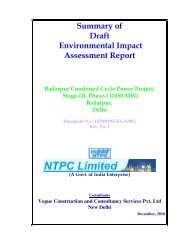proposed integrated complex for delhi judicial academy
proposed integrated complex for delhi judicial academy
proposed integrated complex for delhi judicial academy
Create successful ePaper yourself
Turn your PDF publications into a flip-book with our unique Google optimized e-Paper software.
Rapid Environmental Impact Assessment (REIA) Study <strong>for</strong> Proposed Integrated Complex <strong>for</strong> Delhi Judicial Academy,<br />
National Law School, and National Institute <strong>for</strong> Mediation & Conciliation at Dwarka, New Delhi<br />
Keeping above issues under considerations, an Environmental Impact Assessment (EIA) study is<br />
conducted which incorporates into development and planning process, a plan <strong>for</strong> environmental<br />
protection and conservation. The procedure identifies the possible positive and negative impacts on<br />
the environment likely to emanate as a result of construction and operation of a project. The EIA<br />
thus, provides <strong>for</strong> a plan which, upon implementation, will reduce or offset the negative impacts of<br />
a project resulting in a minimum level of environmental degradation. This minimization may be a<br />
result of implementation of a project modifications or environmental protection measures which<br />
simply reduces the severity or number or magnitude of negative impacts. The plan may also result<br />
in utilization of positive impacts <strong>for</strong> enhancement measures which offset negative impacts.<br />
To measure the level of plan implementation and the degree of effectiveness of the above<br />
environmental protection provisions, the EIA provides a monitoring programme. This programme<br />
is so designed that it identifies the parameters of uncertainty and measures the related impacts.<br />
It is necessary that there is close integration of EIA with various aspects of a project including<br />
financial and engineering aspects which ensures environmental consideration are given due weight<br />
in project selection, siting design and operation.<br />
Analysis of past experiences indicate that it is necessary to examine a number of problem areas in<br />
order to ensure that environmental concerns can be effectively <strong>integrated</strong> in the development<br />
process. Similar approach has been adopted while conducting the REIA study <strong>for</strong> the <strong>proposed</strong><br />
<strong>integrated</strong> Judicial Academy <strong>complex</strong>.<br />
1.6 Stages in the REIA Study<br />
The purpose of this section is to enumerate the methodology <strong>for</strong> Rapid Environmental Impact<br />
Assessment (REIA) which has been followed <strong>for</strong> this study. Any activity involving construction<br />
and operation is expected to cause impacts on surrounding environment. The impacts may be<br />
adverse or beneficial, short term or long term, and reversible or irreversible. In order to assess the<br />
significance of impacts, various steps that are used in conducting an REIA within core and buffer<br />
zone around the <strong>proposed</strong> project construction site are divided into the following phases:<br />
• Identification of significant environmental parameters and assessing the existing status within<br />
the impact zone with respect to air, water, noise, land, biological, and socioeconomic<br />
components of environment.<br />
• Study of various activities of the <strong>proposed</strong> project components to identify the areas leading to<br />
impact/change in environmental quality.<br />
15
















